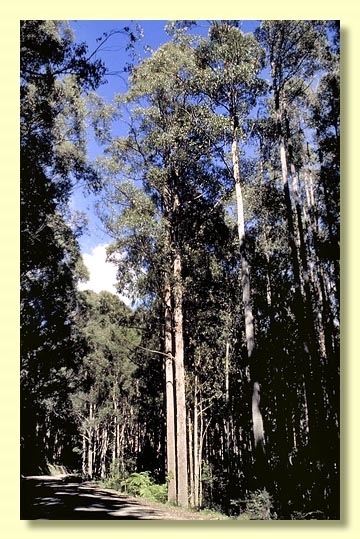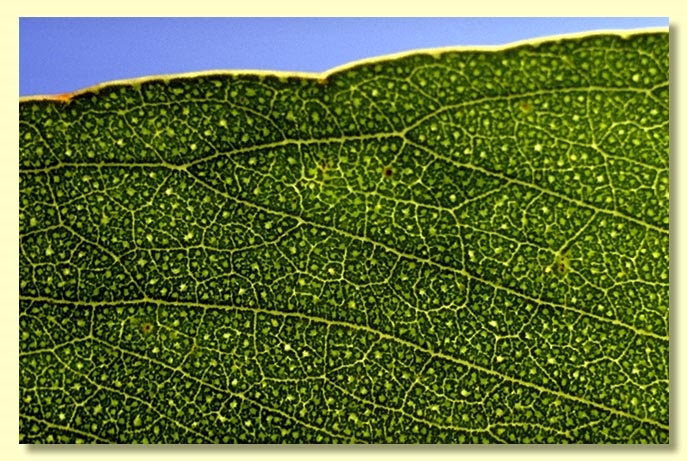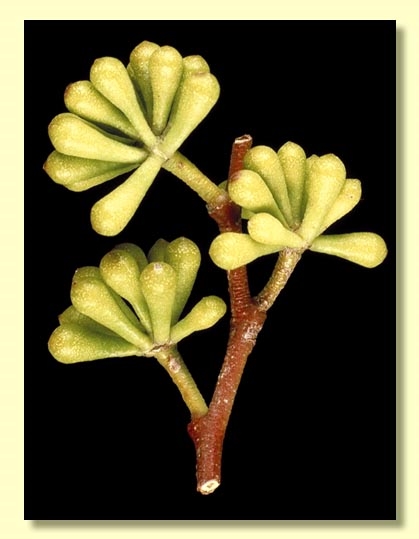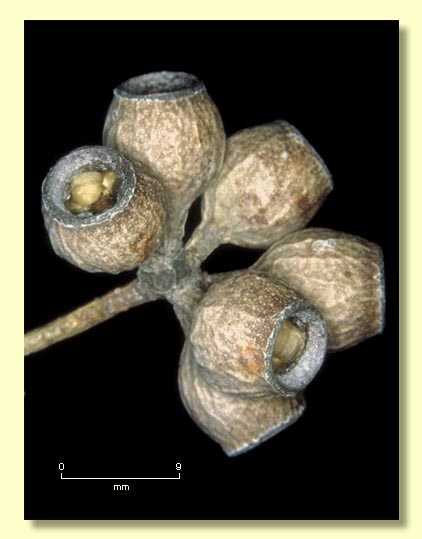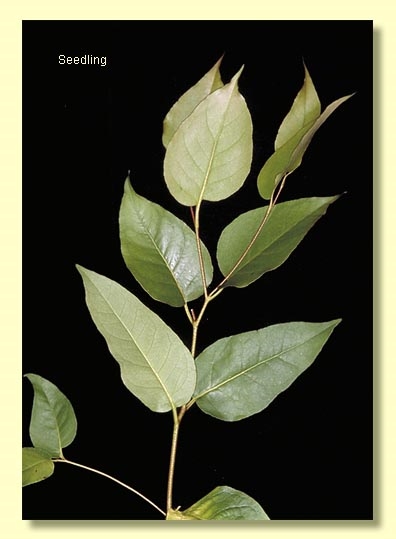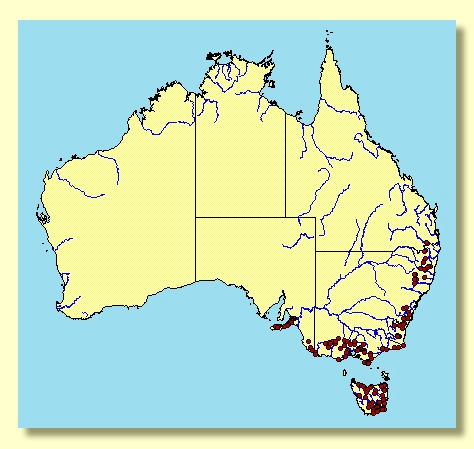Euclid - Online edition
Eucalyptus obliqua
Eucalyptus | Eucalyptus | Eucalyptus | Eucalyptus
T: Adventure Bay, [Tasmania], 26 Jan. 1777, D.Nelson s.n.; holo: BM.
Eucalyptus pallens DC., Prodr. 3: 219 (1828). T: Australia 1823, F.W.Sieber 606; holo: G; iso: NSW.
Eucalyptus procera Dehnh., Cat. Pl. Hort. Camaldulensis 2nd edn, 6, 20 (1832). T: cultivated, Hortus Camaldulensis, Italy.
Eucalyptus fabrorum Schldl., Linnaea 20; 656 (1847). T: not designated.
Eucalyptus heterophylla Miq., Ned. Kruidk. Arch. 4: 141 (1856). T: Tasmania, C.Stuart 2; herbarium of cited specimen not known to us.
Eucalyptus falcifolia Miq., op. cit. 4: 136 (1856). T: Lofty Ra., S.A., F.Mueller s.n.; holo: MEL.
Eucalyptus nervosa F. Muell. ex Miq., op. cit 4: 139 (1856), nom. illeg. non Hoffmanns. (1824). T: Lofty Range, S.A., Nov. 1848, F.Mueller s.n.; holo: MEL.
Eucalyptus obliqua var. degressa Blakely, Key Eucalypts 195 (1934). T: Ambleside, S.A., 24 Mar. 1923, J.B.Cleland & E.H.Ising s.n.; holo: NSW; iso: AD.
Eucalyptus obliqua var. megacarpa Blakely, Key Eucalypts 194 (1934). T: near Lake Bonney, S.A., 7 Dec. 1922, J.B.Cleland s.n.; syn: NSW, AD: Millicent, S.A., 5 Dec. 1917, J.M.Black 1: syn: AD, NSW; Millicent, S.A., 8 Dec. 1922, J.B.Cleland 95: syn: AD, NSW.
Bark rough to small branches or sometimes branches < 8 cm diameter smooth; rough bark stringy or fibrous, brown to grey-brown, longitudinally furrowed; smooth bark green or grey.
Juvenile growth (coppice or field seedlings to 50 cm): stem rounded square in cross-section, warty or smooth; juvenile leaves initially subsessile and opposite for 2–7 nodes then alternate, petiolate, pendulous, broadly ovate to lanceolate or falcate, 6–21 cm long, 2.3–8.5 cm wide,base initially lobed to rounded but oblique by ca node 7, glossy, green.
Adult leaves alternate, petiole 0.7–3.4 cm long; blade lanceolate to falcate, 6–22 cm long, 1.5–7 cm wide, base usually oblique, concolorous, glossy, green, side-veins acute, sparsely to moderately reticulate, intramarginal vein parallel to and well removed from margin, oil glands island, irregular or obscure.
Inflorescence axillary unbranched, peduncles 0.4–2.5(3.1) cm long, buds 11 to 15 or more per umbel, pedicels (0.1)0.3–0.8 cm long. Mature buds obovoid or clavate, 0.4–0.9 cm long, 0.3–0.5 cm wide, green to yellow, usually smooth, scar absent, operculum conical to rounded, stamens erect or irregularly flexed, anthers reniform to cordate, versatile, dorsifixed, dehiscing by confluent slits (usually), style long, stigma tapered, locules 3 or 4, the placentae each with 2 vertical ovule rows. Flowers white.
Fruit on pedicels 0.1–0.5 cm long, cup-shaped or barrel-shaped, 0.6–1.2 cm long, 0.5–1.1 cm wide, disc usually descending, valves 3 or 4, near rim level or enclosed.
Seeds brown, 1.5–3 mm long, pyramidal or obliquely pyramidal, dorsal surface smooth, hilum terminal.
Cultivated seedlings (measured at ca node 10): cotyledons reniform; stems rounded in cross-section; leaves sessile to shortly petiolate, opposite, ovate-elliptic and discolorous for ca 2–4 nodes then becoming alternate, ovate to broadly lanceolate, 5–17 cm long, 2.7–7.5 cm wide, base rounded to tapering to oblique, apex pointed, glossy, mid-green.
Flowering has been recorded in January, February, March, May, June, September, October and December.
A small to tall tree widespread in wet forests and coastal localities from Kangaroo Island in South Australia through southern Victoria, Tasmania and eastern New South Wales, with a few very disjunct occurrences in far south-eastern Queensland extending to Mt Castle at the south end of the Mistake Mountains (north-east of Warwick). It occurs on well-drained soils.
Eucalyptus obliqua has thick, stringy rough bark over the trunk extending to the branchlets. It belongs in the green-leaved ash group and is notable for the large, obliquely ovate, glossy green, petiolate, pendulous juvenile leaves. The adult leaves are glossy green, buds in clusters of 11 to 15 or more, buds pedicellate, obovate. Fruit are usually distinctly pedicellate and barrel-shaped with descending disc. It is never glaucous.
Eucalyptus obliqua belongs in Eucalyptus subgenus Eucalyptus section Eucalyptus series Eucalyptus because of a combination of characters: tall tree habit, fibrous rough bark (to the branches), alternate, green juvenile leaves, sparsely to moderately reticulate adult leaves, single axillary inflorescences with pedicellate buds having only one operculum and reniform anthers, ovules in two rows, and more or less pyramidal seeds. It is most closely related to two other wet sclerophyll forest species, E. regnans and E. fastigata both of which have much smaller cupular-obconical fruit and smooth bark at least on the upper trunks and limbs.
Eucalyptus obliqua was the first eucalypt species described. It was described in 1788 by French botanist L'Héritier from specimens collected in 1777 by plant collector David Nelson at Adventure Bay, Bruny Island, Tasmania, during Captain James Cook's third Pacific expedition with the HM Ships Resolution and Discovery.

